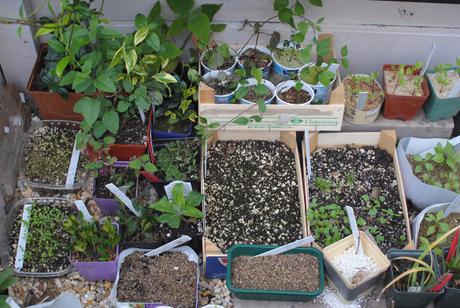I have three weeks to go until our average last frost date.

I did really well this winter, getting seeds sown and potting things on. Now, I’ve got to hang on until the tender things are safe to plant. The cold frame is jammed full.
Hardening off seedlings, though, is too important a process to skip. I skipped it all the time until I built my cold frame–mostly because I didn’t want to spend half the morning bringing trays of plants in and out of the house–and my plants performed correspondingly poorly.
Hardening off is a process of gradually exposing seedlings and tender plants to larger temperature variations and stronger light levels than they experience indoors. The process produces slower, sturdier, more resilient growth, preparing plants for life in the open garden. Without a cold frame, gardeners place plants in a sheltered location outside–maybe in a shaded site, close to the warmth of the house–for a short period of time, lengthening the exposure to outside conditions every few days.
Using a cold frame–basically a tiny greenhouse–makes the process far less tedious. It’s not quite a matter of set-it-and-forget-it, but it frees up lots of the time and space other parts of life demand. My cold frame, which I constructed myself from recycled materials for about $30, faces south and backs up to my house. I start hardening off my seedlings in mid-February, when we begin to see a few 50-degree (10C) days. I start with the hardy perennials, then move in the hardy annuals. Tender plants come last. Space permitting, I sow vegetable seeds in flats directly in the cold frame.
During the first few days in the frame, I place plants on its south side so they sit in slight shadow from the frame’s front wall. They gradually move towards the back as more plants come in. On unusually warm days, I vent the cold frame by propping open the glass doors, made of discarded windows. This keeps the temperatures inside from getting too hot–such fragile plants can quickly dehydrate and die if the temperatures climb too high. Sometimes I’ll prop open the windows entirely, but cover the opening with a bit of horticultural fabric. This practice lets the light in but keeps hungry foraging birds and squirrels and early insect pests out.

The second quadrant of the cold frame.
We’re getting close enough to the last-frost date that I may move out some of the plants with the longest tenancy–particularly the perennials–into permanent locations. They’ve withstood some cold nights already, so a late frost won’t likely bother them.
Believe, gardeners! The digging season is nearly here.

